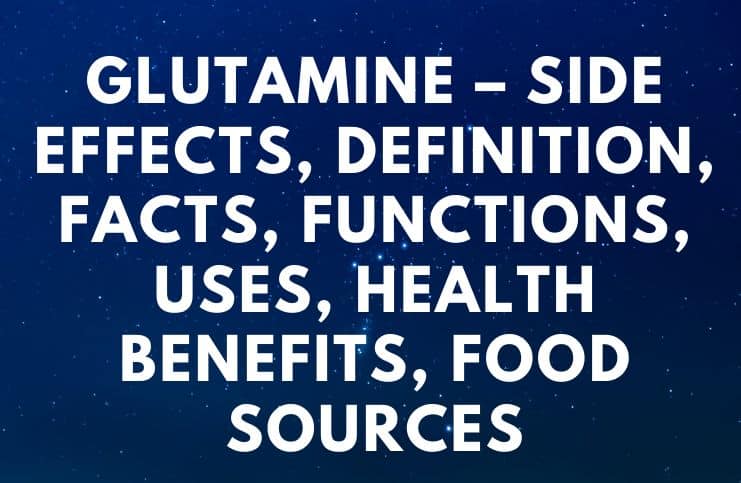Glutamine – Side Effects, Definition, Facts, Functions, Uses, Health Benefits, Food Sources:
Facts
It is the most abundant amino acid in the body, despite the fact that it’s not essential. The majority of this amino acid is stored in muscles, followed by the lungs, where much of the amino acid is made. Chemical formula C5H10N2O3.
It has been called a „conditionally essential” nutrient because it is non-essential in regular situations, but in severe injury or illness becomes insufficient.
This amino acid is a precursor of glutamate, a key amino acid used for the transamination of alpha-keto acids (organic compounds) to form other alpha-amino acids.
Uses and functions
One of the well-established roles of this amino acid in human health is its healthy contribution to the integrity of the intestinal mucosa. This role is slightly related to the fact that it is a critical nitrogen source for rapidly dividing human cells, such as those that line the gastrointestinal tract.
The main location of this amino acid consumption in the body is in the small intestine. Amid times of stress, the small intestine responds by utilizing more Gln and by more efficiently transporting Gln that has been ingested.
It is one of the most readily available non-essential amino acids for use as an energy source and it is an important source of energy for many rapidly dividing cell types in vitro.
Health Benefits
- It improves gastrointestinal health because it is an essential nutrient for the intestines to rebuild and repair.
- It provides energy to neurons when the glycemic levels are low. This aspect of this amino acid is said to lower cravings for alcohol and sugar.
- This amino acid helps the body to produce glutathione, which is a strong antioxidant.
- Improves athletic performance and recovery from endurance exercise.
- It has been used as a component of oral supplementation to reverse muscle wasting (cachexia) in patients with advanced cancer or AIDS/HIV.
- It is also considered important for the maintenance of the renal tubules, contributing to the good and healthy function of the kidneys.
- It plays a central role in both systematic and cellular detoxification processes.
- This amino acid easily crosses the blood-brain barrier, where it is transformed into L-glutamic acid.
- It has also been shown to improve the adverse effects for people who are undergoing chemotherapy for cancer. This is quite useful because in 2017, about 595,690 people will die from the disease in the United States, and 1,685,210 new cases of cancer will be diagnosed.
- By taking it as a supplement, this amino acid can help suppress or curb the sometimes uncontrollable cravings for alcohol or sugary foods.
Food Sources
While your physical body normally produces all the content of this amino acid that it needs, a prolonged illness or a serious injury may require you to increase your dietary intake.
Therefore, foods high in this amino acid, include – spirulina, asparagus, beets, broccoli, wheatgrass, raw parsley, kale, cabbage (especially red cabbage is considered the densest vegetable form of this amino acid) and raw spinach.
Precautions
For children ten years and younger: DO NOT give this amino acid to a child unless your health care specialist prescribes it as part of a complete amino acid supplement.
Side Effects of Glutamine
The intake of supplements with glutamine can have the following side effects:
- swelling in your feet or hands;
- excessive intestinal gas;
- stomach pain;
- vomiting;
- nausea.
People with liver disease, kidney disease, or Reye syndrome (a rapidly progressive encephalopathy) should not take this non-essential amino acid as a nutritional supplement.
It is not 100% known whether it passes into breast milk or if it could harm a nursing baby.
Considering the potential interactions and side effects of medications, you should take nutritional supplements only under the guidance of a knowledgeable healthcare specialist.
READ THIS NEXT:
List of Foods High in Resveratrol
References https://pubchem.ncbi.nlm.nih.gov/compound/GLUTAMINE https://www.sciencedirect.com/topics/neuroscience/glutamine
